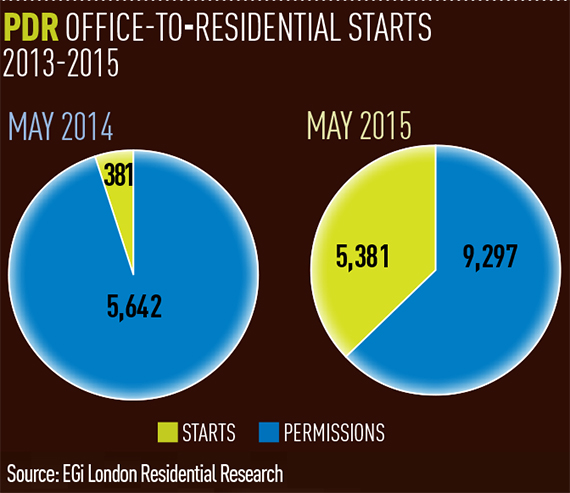 It doesn’t happen often, but once in a while in the world of property research something comes along which is truly unexpected. The rate of office-to-residential starts under permitted development rights is one such matter.
It doesn’t happen often, but once in a while in the world of property research something comes along which is truly unexpected. The rate of office-to-residential starts under permitted development rights is one such matter.
On 30 May 2013, amendments to the Town and Country Planning Order came into force allowing the change of use of offices to residential without the need for planning permission.
A year into the legislation, EGi’s London Residential Research published the first of its reports on PDR. We noted that “with demand high and supply low we would expect to see a torrent of PDR ‘permissions’ being converted to construction starts”. Yet of all the 5,642 units with consent at the end of May 2014, refurbishment to residential had only started on only 381 units.
So despite the frenzy of permissions, something else must be going on. That, we thought, would be leverage, either to facilitate new build by precedent or as a means of reducing the overall affordable contribution of a new-build scheme, or merely as a tool for property traders to increase the value of the building before selling it on.
Two years into the legislation and we are in the process of compiling the data for our third PDR report (published on 29 September). One of the first stages in that process is to visit every site to check on the construction status. As the data trickled in, a rather surprising picture began to emerge. Schemes with PDR consents to convert offices to residential were, despite our initial reservations, starting construction.
That may not appear that surprising until you consider the figures involved. The graphs above display the information to scale, with the green section in each pie chart representing the number of units started at the end of May 2014 and May 2015 from the overall pool of permissible units. At the end of May 2014, a total of 381 PDR units had started construction in the capital; at the end of May 2015, it was 14 times higher, with 5,318 PDR units started.
The significance of those starts remains undiminished even in the broader context of the overall residential figures for the capital. Consider that at the end of 2014 there were 24,806 private residential unit starts in London, if we get a similar figure at the end of 2015 (and we expect it to be greater) then, even as it stands now, PDR schemes would account for nearly 22% of the total. A significant share by any measure.
However, whether PDR will continue to be a feature of the residential landscape is still uncertain. At present the deadline still stands at May 2016 and, with the absence of any comment in this year’s Budget, the general consensus is that a statement, probably for the extension of the legislation, will come in October.
Nigel Evans is head of London Residential Research











